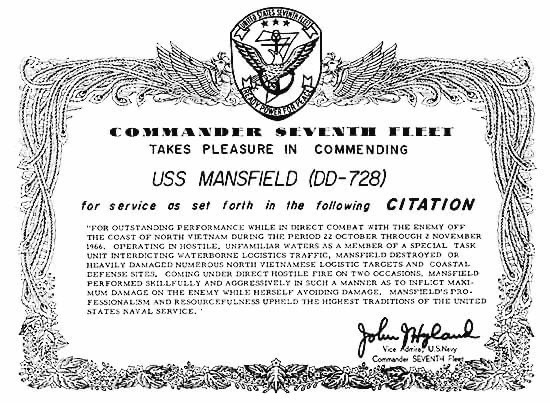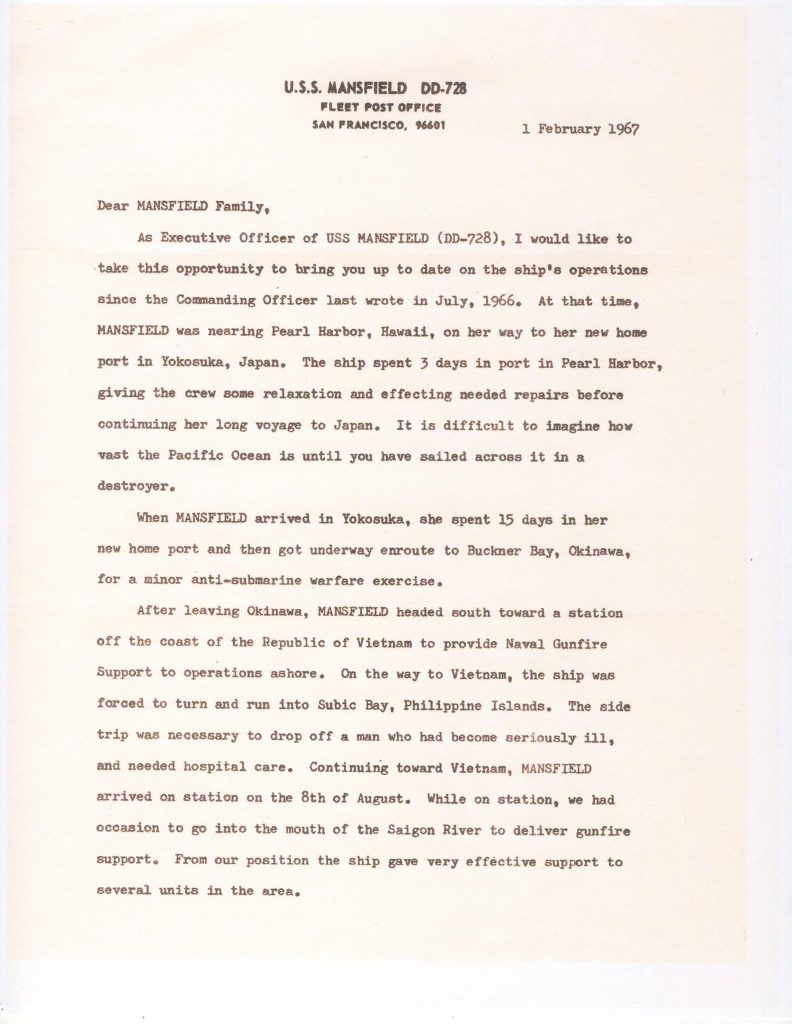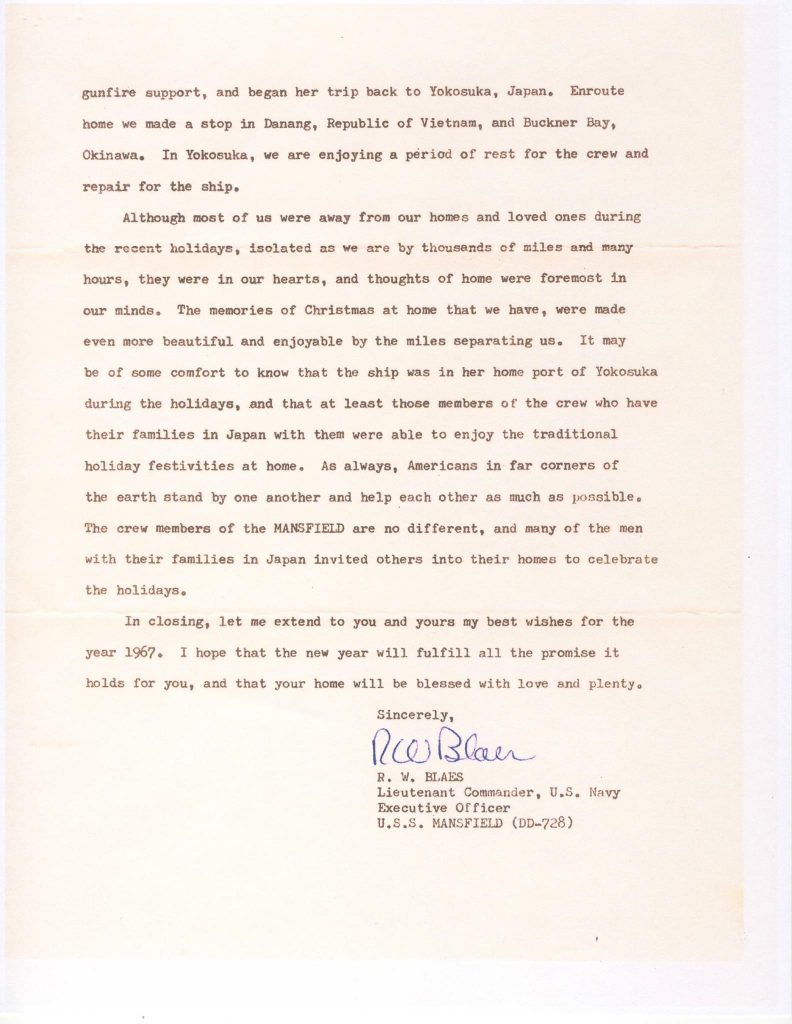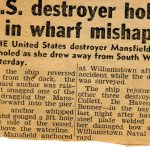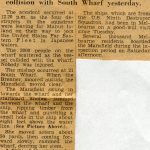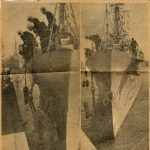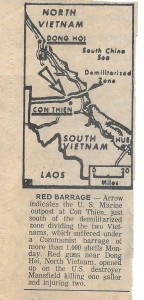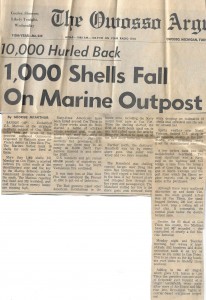The following were contributed by Gary Wigley:
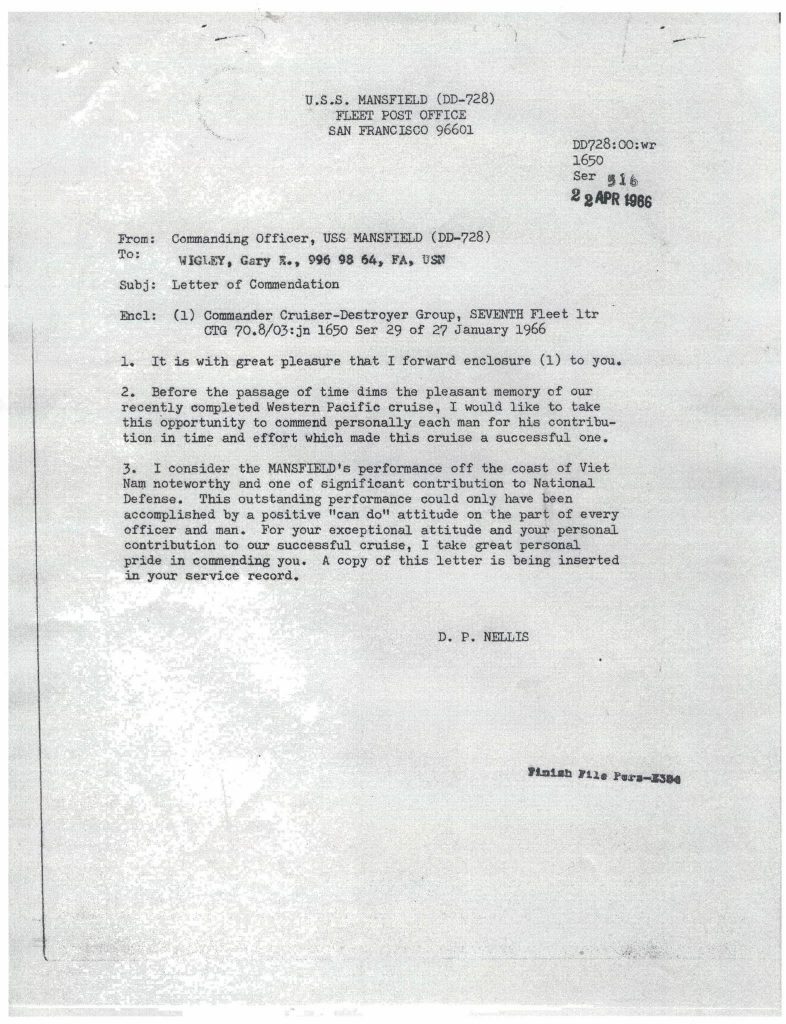 The following were contributed by Randy Smith and Brian Moynihan:
The following were contributed by Randy Smith and Brian Moynihan:
USS Mansfield May 30, 1947 Memorial Day Program
USS Mansfield, DD728 May,30,1947,1
USS Mansfield, DD728 May,30,1947,2
USS Mansfield, DD728 May,30,1947,3
USS Mansfield, DD728 May,30,1947,4
The following was contributed by Michael Hayden, son-in-law of shipmate Robert “Bob” Walsh:
The following was contributed by shipmate Warner Johnson:
 The following articles are courtesy of Bill Payne, USS Benner, 1957. Click on image for bigger view.
The following articles are courtesy of Bill Payne, USS Benner, 1957. Click on image for bigger view.
The following three articles were submitted by Thomas Tompkins, April 2016
These newsletters were sent to family and friends of the crew of USS Mansfield from the ship while it was underway. They gave updates and insight into life aboard ship and the duties and missions performed by the crew. John Armstrong is trying to collect these newsletters and bring them to reunions for people to read. They will also be posted on the website. If you have a copy of any of these documents you can forward them to John Armstrong, 1212 Atwater St., San Diego, CA 92154. If you have an electronic version of the newsletter, please email to Jim Frazier 1papaj1@verizon.net Thank you shipmates.
NEWSLETTERS:
- 1 February 1967 – Courtesy of Gary Wigley, MM3 1965-69
U.S.S. MANSFIELD DD-728
FLEET POST OFFICE
SAN FRANCISCO, 96601
1 February 1967
As Executive Officer of the USS MANSFIELD (DD-728), I would like to take this opportunity to bring you up to date on the ship’s operations since the Commanding Officer last wrote in July 1966. At that time, MANSFIELD was nearing Pearl Harbor, Hawaii, on her way to their new home port in Yokosuka, Japan. The ship spent 3 days in port in Peal Harbor, giving the crew some relaxation and effecting needed repairs before continuing her long voyage to Japan. It is difficult to imagine how vast the Pacific Ocean is until you have sailed across it in a destroyer.
When MANSFIELD arrived in Yokosuka, she spent 15 days in her new home port and then got under way enroute to Buckner Bay, Okinawa, for a minor anti-submarine warfare exercise.
After leaving Okinawa, MANSFIELD headed south toward a station off the coast of the Republic of Vietnam to provide Naval Gunfire Support to operations ashore. On the way to Vietnam, the ship was forced to turn and run into Subic Bay, Philippine Islands. The side trip was necessary to drop off a man who had become seriously ill, and needed hospital care. Continuing toward Vietnam, MANSFIELD arrived on station on the 8th of August. While on station, we had occasion to go into the mouth of the Saigon River to deliver gunfire support. From our position the ship gave very effective support to several units in the area.
On the 19th of August, MANSFIELD was relieved, and started back to Yokosuka for liberty and an upkeep period, arriving in Yokosuka on the 26th of August. On the 7th of September, she cast off her lines once again to steam south and take part in the recovery operation of one of our last Gemini spacecraft. The ship’s function was to cover an area designated as an alternate recovery area in the event that something went wrong, and the astronauts could not bring their craft to earth in the Atlantic as planned. For her special assignment, the MANSFIELD had been fitted with a new crane on the fantail; the crane carried a cradle type device that was designed to pick up the Gemini spacecraft. The ship had also trained men as swimmers to put in the water and attach a floatation belt to the Gemini vehicle. Though it was a slight disappointment to the men of the MANSFIELD not to be in the actual recovery, everything went well for the Gemini team, and the landing was in the Atlantic as planned.
The ship retuned to Yokosuka on the 16th of September, and remained until the 1st of October, when she left enroute to Kobe, Japan. The MANSFIELD went to Kobe on a good-will visit, and to let the crew have some rest and relaxation in a port other than Yokosuka. Kobe turned out to be more than any of the men could have expected, situated as it is in the center of one of the most picturesque and famous areas of Japan. Many of the men took advantage of the opportunity to go on day0long bus tours of the country in and around Kobe. Some of the sights of interest were ancient palaces of the Japanese emperors, very old and famous religious shrines, and industrial complexes in the city of Kobe itself. The MANSFIELD had an open house while she was tied up in Kobe, and over 1,000 Japanese Citizens for Kobe and the vicinity visited the ship. As a demonstration of American friendship with the Japanese people, and as part of the Navy’s PEOPLE TO PEOPLE program, the ship presented several sets of American encyclopedias to the universities and high schools in the Kobe school district. The MANSFIELD also sent a group of volunteers to the Kobe Boy’s Town. The Kobe Boy’s Town is an orphanage for boys patterned after the Boys’ Town in the United States. The volunteers did a wonderful clean-up, fix-up job at the orphanage by painting, repairing siding, plastering walls, and replacing windows. After the repairs at the orphanage, the sailors invited the boys down to the ship, and they were treated to a dinner in the crew’s mess hall. The dinner was followed by a movie show of cartoons, and was much enjoyed by all. As the boys were leaving the ship, their new friends from the MANSFIELD presented them with a large quantity of toys, games, and athletic equipment. On the 8th of October, when the MANSFIELD left Kobe all hands had very fond memories of the wonderful experience behind them.
From Kobe, the ship went to Kaohshung, Taiwan (Formosa). In Kaohshung, we prepared for another anti-submarine exercise. This was a larger exercise than the first, and required very detailed planning. The ship participated in the ASW exercise for three full days. The entire crew gained much valuable experience, and morale was improved by this opportunity to work together as a team. After the exercise the ship returned to Kaohshung for two days before getting underway for Subic Bay, Philippines. In Subic Bay, the ship completed some minor repair work, and refueled before getting underway for what was to us then – a classified operation.
The operation is now history. The MANSFIELD and on other destroyer were the first Navy ships assigned to interdict enemy shipping off the North Vietnamese coastline. Our job was to t destroy junk and sampan traffic from the North into South Vietnam. This waterborne traffic is one of the Communists’ main supply routes for their war of infiltration into South Vietnam. On two occasions while the ship was cruising off the coast and firing at supply junks headed south, the Communist North Vietnamese opened fire with shore batteries directed at the MANSFIELD. The crew responded superbly during these attacks and the ship scored many hits on the gun emplacements ashore without receiving a scratch. Having completed ten days of operations in the North, and destroying or damaging 109 enemy craft along the coast of North Vietnam, the MANSFIELD turned south for more gunfire support duties. On the 19th of November, the ship left the area of Vietnam to go to Hong Kong, British Crown Colony, for duty as the “Station Ship”.
The Station Ship in any port is the ship which assumes the majority of the administrative and logistic support responsibilities for all other Navy ships. The length of our stay in Hong Kong, from the 22nd of November until the 9th of December, 1966, gave the crew an excellent chance to take advantage of the fantastic shopping and low prices of a free port, and also the beautiful scenery of Great Britain’s most famous Island Colony. Getting underway from Hong Kong, the MANSFIELD again headed for their home port. In Yokosuka the ship went through an extended repair period, until after the first of the year.
On the 3rd of January, the ship again got underway from Yokosuka enroute to a station off the coast of the Republic of Vietnam, to provide more naval gunfire support to the United States, Vietnamese and South Korean troops fighting ashore. Upon arrival off the coast of Vietnam, she immediately began to answer calls for supporting fire from units on the beach. The entire twelve-day period of gunfire support duty was marked by long hours and extra work on the part of all hands. The ship remained at the ready 24 hours a day, with the crew manning their stations for 6 hours and they resting for 6 hours. Besides missions in direct support of ground operations, the ship also provided harassment and interdiction fire through the night. This proved to be a very heavy strain, but if we didn’t sleep much, the enemy didn’t either. Periodically, the ship was forced to leave her station to refuel or rearm, and as a general rule these operations were carried on at night hours. Through the fast tempo of operations and long hours of watch, the crew performed in an outstanding manner, once again proving their “can do” spirit. The high morale demonstrated by all hands showed that each man had a feeling of his own importance, and the importance of the vital task his country has entrusted to him. It is the same spirit of the American fighting men that has kept our nation great and will continue to do so even the face of communist aggression. I believe each man realizes that he is here not just to protect the freedom of the Vietnamese people, but ultimately the freedom of all peoples the world over, including our own.
The 1.515 rounds of 5-inch ammunition that the ship fired on this trip south brought her grand total of rounds fired in support of the Vietnamese conflict to 13,250; this is believed to be the largest number of rounds fired by any West Coast destroyer. The MANSFIELD proudly claims the title of the “Biggest Gun in the West”.
On the 22nd of January, MANSFIELD was relieved of her duties of gunfire support, and began her trip back to Yokosuka, Japan. Enroute home we made a stop in Danang, Republic of Vietnam, and Buckner Bay, Okinawa. In Yokosuka, we are enjoying a period of rest for the crew and repair for the ship.
Although most of us were away from our homes and loved ones during the recent holidays, isolated as we are by thousands of miles and many hours, they were in our hearts, and thoughts of home were foremost in our minds. The memories of Christmas at home that we have, were made even more beautiful and enjoyable by the miles separation us. It may be of some comfort to know that the ship was in her home port of Yokosuka during the holidays, and that at least those members of the crew who have their families in Japan with them were able to enjoy the traditional holiday festivities at home. As always, Americans in far corners of the earth stand by one another and help each other as much as possible. The crew members of the MANSFIELD are no different, and many of the men with their families in Japan invited others into their homes to celebrate the holidays.
In closing, let me extend to you and yours my best wishes for the year 1967. I hope that the new year will fulfill all the promise it holds for you, and that your home will be blessed with love and plenty.
Sincerely,
R.W. BLAES
Lieutenant Commander, U.S. Navy
Executive Officer
U.S.S. MANSFIELD (DD-728)
The following courtesy of SN1/C John Ladany (52-53).
DISCLAIMER: ALL NAMES AND EVENTS WITHDRAWN FROM A 40+ YEAR OLD MEMORY BANK!
CORRECTIONS AND ADDITIONS WELCOMED
Island Rest After Action

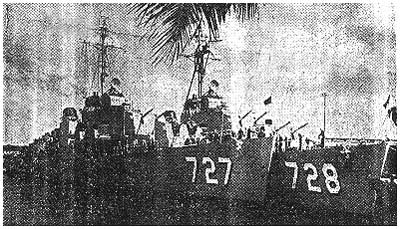
IN PEARL HARBOR – Two of the four destroyers stopping over in Pearl Harbor today are the DeHaven (727) and the Mansfield (728). The ships are part of Destroyer Division 91, which is the first to complete a third tour of the Korean area since the beginning of hostilities. – Navy Photo.
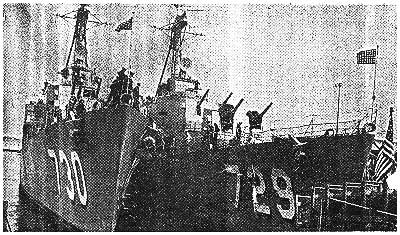
EN ROUTE HOME – Their tour of blockade and patrol duty along the Korean coast completed, these two destroyers – Collett (730) and Swenson (729) – with two other fighting ships of Destroyer Division 91 scheduled to leave Pearl Harbor tomorrow for Long Beach, Calif., their home port. – Navy Photo.
Destroyer Division Arrives After Third War Area Tour
Destroyer Division 91, the first to complete a third tour of duty in the Far East since the beginning of the Korean War, is at Pearl Harbor today.
The Mansfield, Collett, Lyman K. Swenson, and DeHaven, the four ships in the division, will leave tomorrow for Long Beach, Calif., their home port.
During this last tour, the division was assigned duty with Task Force 95 for blockade and patrol duty on the Korean coast and with Fast Carrier Task Force 77 for protection against enemy planes and submarines.
In October and November, while assigned to Task Force 95, the destroyers provided fire support for United Nations ground forces, conducted harassing missions against enemy supply lines, served as search and rescue destroyers for downed allied airmen, and kept a tight blockade of enemy ports.
PROTECT NANDO ISLE
For two days the Collett was assigned the protection of Nando Island just north of Wonsan. During that time, enemy shore batteries opened close fire on her, but she escaped undamaged.
In October, the Mansfield was also taken under heavy fire by enemy shore batteries but returned the fire so effectively that the enemy was silenced.
While the Swenson was operating in the Yellow Sea with ships of the British Commonwealth, the DeHaven rescued the pilot of a battle-damaged Navy attack bomber which had crash-landed in the sea.
LEFT FOR FORMOSA
From Yokosuka, the division left for the Formosa Straits for patrol of the waters between Red China and the Chinese Nationalist on the Island of Formosa.
The Mansfield served double duty during the patrol by functioning as a training vessel for Nationalist Chinese Navy men. the Chinese, from Kaohsiung, Formosa, learned Naval engineering practices from members of the Mansfield crew.
After a trip to Sasebo for repairs, the ships again joined Task Force 77 for more blockade, fire support and interdiction duty off the North Korean coast.
[Rest of article unavailable.]
Newspaper Articles
Thanks to shipmate Jim Frazier for copies of these articles
DESTROYER DIVISION 92 RETURNS FROM 7TH
LONG BEACH DISPATCH Feb. 11, 1966
In Vietnam these days fighting ground forces from both camps are keeping a closer watch over the sea.
If they happen to be Viet Cong, they’re also keeping closer tabs on the rivers. Particularly the Saigon River.
Hard-hitting U.S. Navy destroyers, the sleek greyhounds of naval action off Vietnam, are the cause of it all. Almost daily they are demonstrating – sometimes in wondrous ways – that they will go anywhere and do anything to save a life. Or take it.
Three ships of Destroyer Division 92, which returned to their homeport of Long Beach February 7 following a six-month deployment with the Seventh Fleet, will vouch for this.
While steaming in Southeast Asian waters, the ships carried out a multitude of jobs ranging from humanitarian speed runs to the obliteration of hard-rock Viet Cong positions.
The ships are the destroyers Ozbourn (DD-846), Chandler (DD-717) and Mansfield (DD-728), whose skippers respectively are Commanders Marvin D. Nelson Jr., John R. Crumpton Jr. and Donald P. Nellis, all of Long Beach.
Commander of the division is Captain G.A. Mitchell, also of Long Beach, who led the ships into Long Beach harbor aboard his flagship, the Ozbourn.
During operations against Viet Cong forces in Vietnam, DesDiv 92 ships fired 7,000 rounds, or 280 tons, of five-inch projectiles at enemy positions. This gunfire damaged or destroyed more than 500 enemy structures, 4 loaded supply trucks, 18 junks and sampans, 7 bridges, 3 automatic weapons emplacements, 3 bunkers and a cave.
The destroyers also are credited with killing more than 125 and wounding over 100 enemy troops.
The Mansfield alone hurled more than 5,000 rounds of five-inchers at the Viet Cong in operations that ranged from the coastline to more than 13 miles up the Saigon River. The ship is credited with destroying 7 bridges and more thatn 350 enemy structures.
In addition to combat operations, DesDiv 92 ships participated in humanitarian projects designed to promote better understanding between the United States and friendly Asian nations.
Mansfield sailors donated more than 100 pints of blood for use in Vietnam. They also donated toys to the Onesiphorus Children’s Home in Hong Kong.
Red Shore Guns Hit Destroyer Mansfield
SAIGON (AP) – One round from North Vietnamese shore batteries hit the 2,200-ton U.S. Navy destroyer Mansfield in the Gulf of Tonkin, killing one crewman and wounding two others, the Navy announced today.
The Navy said the round Monday punched a hole four feet in diameter at the base of the destroyer’s fire stack and cut a few lighting cables. Forty-seven more rounds fell into the water around the ship.
The Mansfield, which has six five-inch guns, was firing on waterborne supply craft near Dong Hoi, about 35 miles north of the demilitarized zone.
Shrapnel penetrated the forward fire room and a passageway but inflicted only light damage, the Navy said.
“THE DESTROYER responded by returning numerous rounds of fire from her five-inch guns until the coastal defense site became silent,” a Navy communique said. “The casualties were then evacuated to the anti-submarine aircraft carrier USS Hornet.”
USS Mansfield Crew Boasts Custom Checks
LONG BEACH DISPATCH Sunday, June 22, 1969
It wasn’t planned that way, but Bank of America is providing custom-made checks for one of the Navy’s most distinguished ships.
While both the bank and the ship’s officers and crew are delighted with the arrangement, it never would have happened if it hadn’t been for the skipper, Commander Paul Anderson of the destroyer USS Mansfield.
Last month while the Mansfield was in San Diego on a six-week refresher training program, Commander Anderson, a BankAmericard holder, received a brochure advertising Bank of America’s new California scenic checks.
One of the 10 scenes is the San Diego skyline and harbor with a ship in the foreground.
Although the photograph was only one-fourth the actual check size, Commander Anderson thought he recognized the barely visible number in the ship’s hull as the Mansfield’s “728.”
WHEN THE VESSEL RETURNED to is Long Beach home port, Commander Anderson went to the bank’s Terminal Island branch and inspected a poster-size photograph of the San Diego scene. It clearly showed the pictured ship was indeed the Mansfield.
Although the Mansfield appeared in the San Diego shot purely by chance, the bank could hardly have chosen a more deserving subject.
The Mansfield has been in continuous commission for the past 25 years, undergoing heavy combat duty in World War II, Korea, and Vietnam, and has participated in two NASA space shot recovery operations.
Recently back from two years duty in Vietnam – and scheduled to return in September – it currently holds the record for the most rounds fired by a destroyer in Vietnam and was one of the prime reasons its squadron, Destroyer Division 92, was recently cited by the Secretary of the Navy as one of the most outstanding destroyer units in the Pacific Fleet.
WHEN the bank learned of all this, it made an enlargement of the San Diego check with a personal greeting from Board Chairman Louis B. Lundborg and formally presented it to Commander Anderson and his crew of the ship’s wardroom. Plans also are being made to use the photograph on the ships official stationery.
As things worked out, the Navy, the Mansfield and Bank of America all profited by the coincidence – and Commander Anderson’s sharp eye.
The Navy can boast that thousands of Californians will be writing their personal checks over a picture of one of its proudest ships.
The 295-man Mansfield crew can enjoy the most personalize bank checks ever offered anyone.



